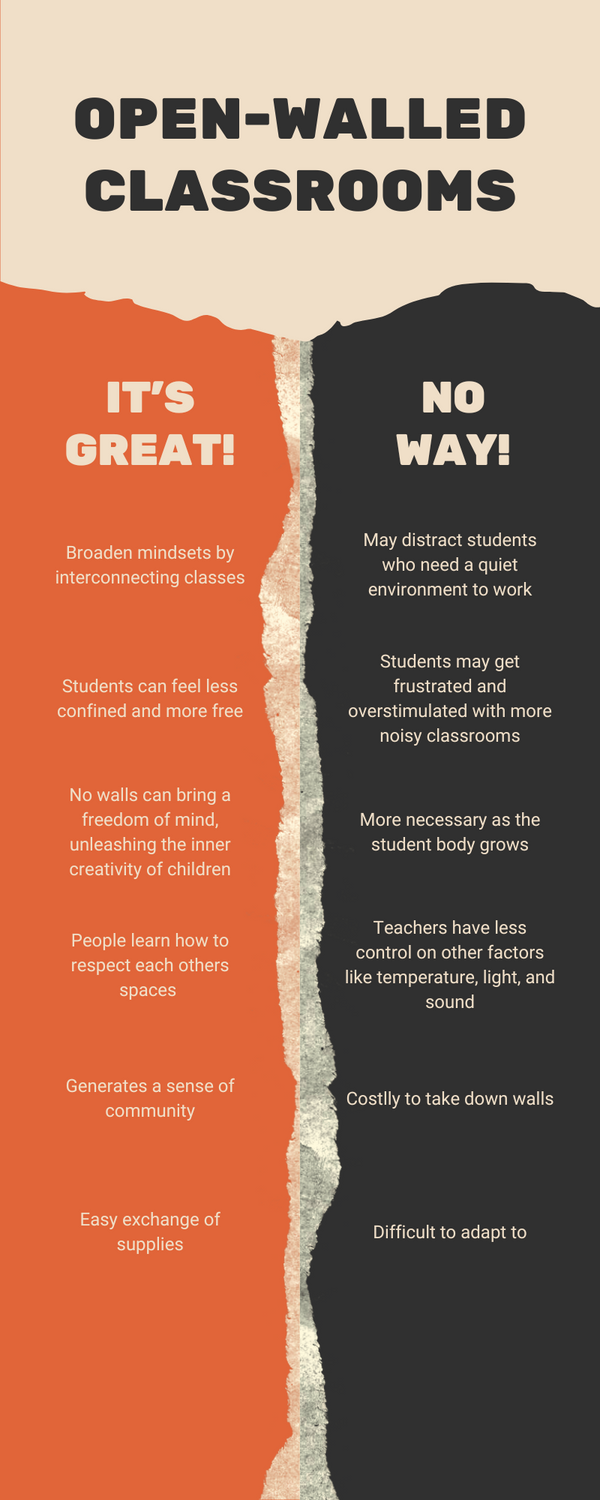A new topic has been drawing a lot of attention within schools from all over, having teachers question whether or not they should incorporate open-walled classrooms into their buildings. With this new idealistic floor plan, walls in between classrooms would be taken down to create a more open, collaborative space. Although some people believe that this could provide excellent opportunities to schools, others believe that it would be an absurd waste of money to knock down walls to have an open space, especially when budgets should be spent elsewhere.
Open-walled classrooms have no dividers separating certain classrooms, which can be seen as both beneficial and harmful. On the positive side, this strongly encourages collaboration between two classes. Given this collaboration, students can broaden their fixed minds to create connections joining two distinct areas of study. Not only this, but students feel less confined in the walls of the classroom. This new freedom of space can come with freedom of mind, unleashing the inner creativity of children. The format and configuration of desks, chairs, and supplies can easily be changed as well, allowing both students and teachers to step into their same, but different, place of work each morning.
Mrs. Bounaccore, the high school photo teacher, recalls her time in the past spent with open walled classrooms in our school, “I remember the center area of the second level of the school having walls as partitions, but they didn’t go all the way up to the ceiling. It was amazing how it worked out. People were respectful of each other in that they made sure their voices were low enough. It seemed to work, and it was nice in the sense that there was a strong sense of community because you were always in each other’s spaces. Our school has grown since this time, so it is hard to compare and imagine if the open-walled classrooms would still be successful.”
As Mrs. Bounaccore says, the open-walled classroom system had worked in the past, yet it is hard to determine whether or not it would still be successful today. At the same time, this large and open wall-less space can be very distracting to students who enjoy working in peace. With all the other noises and actions taking place around a classroom, it is easy for one to get very frustrated and overstimulated, which can hinder their learning and the quality of their work. Not only this, but teachers have limited control over the classroom if no walls are present. Factors including temperature, light, and sound can impact the kid’s concentration, and the teachers can no longer regulate these components. Another relevant point brought up is the lack of security if there were no walls to protect and shield the students. “I think that walls are pretty important in a very large population, and they help students to focus on what they are doing versus other classrooms. I don’t have any experience with having no walls, so I guess I would give it a try if it were the right circumstances!” exclaims high school art teacher Mrs Petras. This exact open-mindedness with the teachers allows this debate to thrive, posing great arguments both for and against it. Blind Brook High School currently does not have any open-walled classrooms, but you never know what the future may hold!







